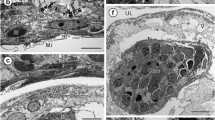Abstract.
Trophoblastic adhesion to, and penetration of, the uterine epithelium during implantation have been examined in captive-bred Carollia perspicillata at the light and electron microscopic levels. Initial adhesion is localized to marginal ridges immediately over the apical intercellular junctions of the epithelial cells. Penetration then involves the intrusion of trophoblastic processes between the epithelial cells and the formation of junctional complexes between the two cell types. As larger areas of adhesion develop, they still occur most often near the intercellular boundaries between the more flattened epithelial cells or on their lateral sides. This suggests that many (if not all) of these broad areas of adhesion to the trophoblast had actually formed along what had originally been part of the lateral (rather than the apical) surfaces of the epithelial cells. Portions of the apical cell surfaces further removed from their intercellular boundaries usually were not adherent to the trophoblast and still had microvilli. Upon reaching the basal lamina of the uterine epithelium, invasion of the endometrium is temporarily retarded, and trophoblast cells migrate instead between the basal lamina and the epithelial cells. This occurs extensively along both the luminal and glandular epithelia around the implantation site, but not significantly along their apical surfaces. This again indicates that adhesive interactions between the trophoblast and those apical surfaces are at most very limited in Carollia. The epithelial cells appear to be viable until separated from their basal laminae by the trophoblast. They are then phagocytized by the trophoblast. During initial penetration of the uterine luminal epithelium, the trophoblast is still entirely of the cellular variety. Syncytiotrophoblast does not begin to appear until later, when the trophoblast first comes into contact with endometrial capillaries.
Similar content being viewed by others
Author information
Authors and Affiliations
Additional information
Electronic Publication
Rights and permissions
About this article
Cite this article
Rasweiler, J.J., Oliveira, S.F. & Badwaik, N.K. An ultrastructural study of interstitial implantation in captive-bred, short-tailed fruit bats, Carollia perspicillata: trophoblastic adhesion and penetration of the uterine epithelium. Anat Embryol 205, 371–391 (2002). https://doi.org/10.1007/s00429-002-0267-4
Accepted:
Issue Date:
DOI: https://doi.org/10.1007/s00429-002-0267-4




